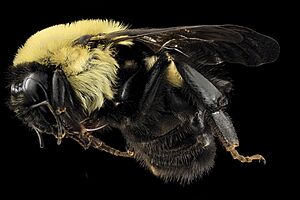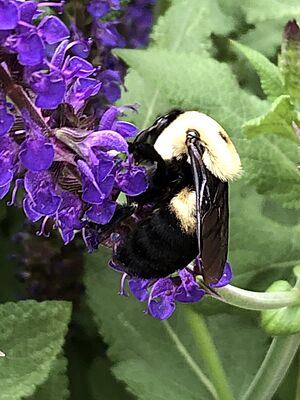Bombus griseocollis facts for kids
Quick facts for kids Bombus griseocollis |
|
|---|---|
 |
|
| Queen | |
| Conservation status | |
| Scientific classification | |
| Genus: |
Bombus
|
| Species: |
griseocollis
|
The brown-belted bumblebee (scientific name: Bombus griseocollis) is a type of bumblebee. You can find it in most parts of the United States, except for the Southwest. It also lives in the southern areas of several Canadian provinces.
Contents
What Does the Brown-Belted Bumblebee Look Like?
These bumblebees come in different sizes depending on their role in the colony.
- Queens are the largest, usually about 2.1 to 2.3 centimeters long. Their head and face are black with some yellow hairs. Their main body (thorax) is covered in yellow hairs. The back part of their body (abdomen) is yellow with black bands. Their legs are black.
- Workers are smaller than the queen, sometimes less than a centimeter long. They look similar to the queen but might have a yellow-brown band on their abdomen.
- Males are about 1.5 to 1.9 centimeters long. They have very large eyes that take up about two-thirds of their head's width. Their face and thorax have yellow hairs, and their abdomen has bands of yellow, yellow-brown, and black.
- Eggs are small, white, and slightly curved. They are about 2.8 to 3.1 millimeters long.
Where Do Brown-Belted Bumblebees Live and What Do They Do?
This bumblebee can live in many different places. You might find it in meadows, wetlands, farm fields, and even busy cities. They are important pollinators in community gardens. They have even been seen near the top of the Empire State Building in New York City! These bees have been found across Canada and every state in the continental United States.
These bees get their food from many different plants. Some of their favorites include milkweeds, prairie clovers, echinaceas, loosestrife, bergamot, pickerel weeds, rudbeckias, goldenrods, clovers, and vetches. Queens especially like legume plants.
How Do Brown-Belted Bumblebees Live Together?
Brown-belted bumblebees are eusocial bees. This means they live in a colony where everyone works together. They divide up tasks to raise their young. Some bees reproduce, and others do not.
Their nests are usually found underground or on the surface. These colonies are often small, with fewer than 50 worker bees. But don't let their size fool you, they are very good at defending their homes!
Worker bees do most of the daily jobs in the nest, no matter their age. Some of their tasks include:
- Making wax and using it to stick the nest to a surface.
- Collecting materials to keep the nest warm.
- Keeping young bees (pupae) warm by wrapping their bodies around their cocoons.
- Feeding the baby bees (larvae) by bringing them food.
- Cleaning the nest by removing old wax and reusing it for honey pots.
- Buzzing loudly when they sense danger.
- Checking and patrolling the nest.
- Finding food outside the nest.
What Do Male Bumblebees Do?
Male bumblebees have a special job: they mate with the queens. They often wait in places where young queens might fly by. Males mark their waiting spots with a special scent. This scent might be a signal to other males.
Interestingly, male brown-belted bumblebees also help keep the young bees warm. This is unusual, as in most bee species, only workers do this. They wrap themselves around the cocoons and pump their abdomens to create heat. While males can't make the temperature as high as queens can, they can help keep it warm.
Do Brown-Belted Bumblebees Have Predators?
Like many insects, these bumblebees can be attacked by parasites. One type of parasite is the thick-headed fly. These flies sometimes force their victims to dig their own graves. However, brown-belted bumblebees are quite resistant to this "mind control." Only about 18% of them give in, which is much less than other bumblebee species.
Are Brown-Belted Bumblebees in Danger?
This is a common species across its wide range. Unlike many other bumblebees in North America, its numbers have not gone down. In some areas, their populations might even be growing! This means they don't seem to face any serious threats right now.



